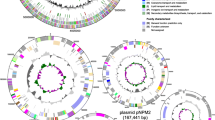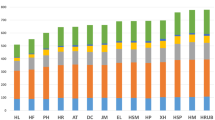Abstract
The genus Herbaspirillum gained the spotlight due to the several reports of diazotrophic strains and promising results in plant-growth field assays. However, as diversity exploration of Herbaspirillum species gained momentum, it became clearer that the plant beneficial lifestyle was not the only form of ecological interaction in this genus, due to reports of phytopathogenesis and nosocomial infections. Here we performed a deep search across all publicly available Herbaspirillum genomes. Using a robust core genome phylogeny, we have found that all described species are well delineated, being the only exception H. aquaticum and H. huttiense clade. We also uncovered that the nif genes are only highly prevalent in H. rubrisubalbicans; however, irrespective to the species, all nif genes share the same gene arrangement with high protein identity, and are present in only two main types, in inverted strands. By means of a NifHDKENB phylogenetic tree, we have further revealed that the Herbaspirillum nif sequences may have been acquired from the same last common ancestor belonging to the Nitrosomonadales order.






Similar content being viewed by others
References
Dixon R, Kahn D (2004) Genetic regulation of biological nitrogen fixation. Nat Rev Microbiol 2:621–631. https://doi.org/10.1038/nrmicro954
Carvalho TLG, Balsemão-Pires E, Saraiva RM et al (2014) Nitrogen signalling in plant interactions with associative and endophytic diazotrophic bacteria. J Exp Bot 65:5631–5642. https://doi.org/10.1093/jxb/eru319
Smercina DN, Evans SE, Friesen ML, Tiemann LK (2021) Temporal dynamics of free-living nitrogen fixation in the switchgrass rhizosphere. GCB Bioenergy 13:1814–1830. https://doi.org/10.1111/gcbb.12893
Zhang, W., Hou, W., Zeng, X., et al.: High abundance of Thaumarchaeota found in deep metamorphic subsurface in eastern China. Microorganisms. 10, (2022). https://doi.org/10.3390/microorganisms10030542
Matson AL, Corre MD, Burneo JI, Veldkamp E (2015) Free-living nitrogen fixation responds to elevated nutrient inputs in tropical montane forest floor and canopy soils of southern Ecuador. Biogeochemistry 122:281–294. https://doi.org/10.1007/s10533-014-0041-8
Chubatsu LS, Monteiro RA, de Souza EM et al (2012) Nitrogen fixation control in Herbaspirillum seropedicae. Plant Soil 356:197–207. https://doi.org/10.1007/s11104-011-0819-6
Dos Santos PC, Fang Z, Mason SW et al (2012) Distribution of nitrogen fixation and nitrogenase-like sequences amongst microbial genomes. BMC Genomics 13:1–12. https://doi.org/10.1186/1471-2164-13-162
Koirala, A., Brözel, V.S.: Phylogeny of nitrogenase structural and assembly components reveals new insights into the origin and distribution of nitrogen fixation across bacteria and archaea. Microorganisms 9, (2021). https://doi.org/10.3390/microorganisms9081662
AE Araújo da S, Baldani VLD, P Galisa de S et al (2013) Response of traditional upland rice varieties to inoculation with selected diazotrophic bacteria isolated from rice cropped at the Northeast region of Brazil. Appl Soil Ecol 64:49–55. https://doi.org/10.1016/j.apsoil.2012.10.004
Alves GC, Dos Santos CLR, Zilli JE et al (2021) Agronomic evaluation of Herbaspirillum seropedicae strain ZAE94 as an inoculant to improve maize yield in Brazil. Pedosphere 31:583–595. https://doi.org/10.1016/S1002-0160(21)60004-8
Alves GC, Videira SS, Urquiaga S, Reis VM (2015) Differential plant growth promotion and nitrogen fixation in two genotypes of maize by several Herbaspirillum inoculants. Plant Soil 387:307–321. https://doi.org/10.1007/s11104-014-2295-2
Liu Y, Ludewig U (2020) Improved establishment of Miscanthus × giganteus stem propagation by Herbaspirillum inoculation. Ind Crops Prod 150:112339. https://doi.org/10.1016/j.indcrop.2020.112339
Faoro H, Oliveira WK, Weiss VA et al (2019) Genome comparison between clinical and environmental strains of Herbaspirillum seropedicae reveals a potential new emerging bacterium adapted to human hosts. BMC Genomics 20:1–15. https://doi.org/10.1186/s12864-019-5982-9
Baldani JI, Rouws L, Cruz LM et al (2014) The family Oxalobacteraceae. In: Schmid M, Hartmann A (eds) The Prokaryotes. Springer, Berlin Heidelberg, Berlin, Heidelberg, pp 919–974
Straub D, Rothballer M, Hartmann A, Ludewig U (2013) The genome of the endophytic bacterium H. frisingense GSF30T identifies diverse strategies in the Herbaspirillum genus to interact with plants. Front Microbiol 4:1–10. https://doi.org/10.3389/fmicb.2013.00168
Straub D, Yang H, Liu Y et al (2013) Root ethylene signalling is involved in Miscanthus sinensis growth promotion by the bacterial endophyte Herbaspirillum frisingense GSF30 T. J Exp Bot 64:4603–4615. https://doi.org/10.1093/jxb/ert276
Rothballer M, Eckert B, Schmid M et al (2008) Endophytic root colonization of gramineous plants by Herbaspirillum frisingense. FEMS Microbiol Ecol 66:85–95. https://doi.org/10.1111/j.1574-6941.2008.00582.x
Pedrosa FO, Monteiro RA, Wassem R et al (2011) Genome of Herbaspirillum seropedicae strain SmR1, a specialized diazotrophic endophyte of tropical grasses. PLoS Genet 7:e1002064. https://doi.org/10.1371/journal.pgen.1002064
Tuleski TR, Kimball J, Do Amaral FP et al (2020) Herbaspirillum rubrisubalbicans as a phytopathogenic model to study the immune system of Sorghum bicolor. Mol Plant-Microbe Interact 33:235–246. https://doi.org/10.1094/MPMI-06-19-0154-R
Li W, O’Neill KR, Haft DH et al (2021) RefSeq: Expanding the Prokaryotic Genome Annotation Pipeline reach with protein family model curation. Nucleic Acids Res 49:D1020–D1028. https://doi.org/10.1093/nar/gkaa1105
Manni M, Berkeley MR, Seppey M et al (2021) BUSCO update: novel and streamlined workflows along with broader and deeper phylogenetic coverage for scoring of eukaryotic, prokaryotic, and viral genomes. Mol Biol Evol 38:4647–4654. https://doi.org/10.1093/molbev/msab199
Seemann T (2014) Prokka: rapid prokaryotic genome annotation. Bioinformatics 30:2068–2069. https://doi.org/10.1093/bioinformatics/btu153
Emms DM, Kelly S (2019) OrthoFinder: phylogenetic orthology inference for comparative genomics. Genome Biol 20:1–14. https://doi.org/10.1186/s13059-019-1832-y
Kim D, Park S, Chun J (2021) Introducing EzAAI: a pipeline for high throughput calculations of prokaryotic average amino acid identity. J Microbiol 59:476–480. https://doi.org/10.1007/s12275-021-1154-0
R Core Team: A Language and Environment for Statistical Computing R Foundation for Statistical Computing, Vienna, Austria (2020)
Pritchard L, Glover RH, Humphris S et al (2016) Genomics and taxonomy in diagnostics for food security: soft-rotting enterobacterial plant pathogens. Anal Methods 8:12–24. https://doi.org/10.1039/c5ay02550h
Paradis E, Claude J, Strimmer K (2004) APE: Analyses of Phylogenetics and Evolution in R language. Bioinformatics 20:289–290. https://doi.org/10.1093/bioinformatics/btg412
Letunic I, Bork P (2019) Interactive Tree of Life (iTOL) v4: recent updates and new developments. Nucleic Acids Res 47:256–259. https://doi.org/10.1093/nar/gkz239
Page AJ, Cummins CA, Hunt M et al (2015) Roary: Rapid large-scale prokaryote pan genome analysis. Bioinformatics 31:3691–3693. https://doi.org/10.1093/bioinformatics/btv421
Katoh K, Standley DM (2013) MAFFT multiple sequence alignment software version 7: improvements in performance and usability. Mol Biol Evol 30:772–780. https://doi.org/10.1093/molbev/mst010
Price, M.N., Dehal, P.S., Arkin, A.P.: FastTree 2 — approximately maximum-likelihood trees for large alignments. PLoS One 5, (2010). https://doi.org/10.1371/journal.pone.0009490
Brynildsrud O, Bohlin J, Scheffer L, Eldholm V (2016) Rapid scoring of genes in microbial pan-genome-wide association studies with Scoary. Genome Biol 17:1–9. https://doi.org/10.1186/s13059-016-1108-8
Chaudhari NM, Gupta VK, Dutta C (2016) BPGA—an ultra-fast pan-genome analysis pipeline. Sci Rep 6:1–10. https://doi.org/10.1038/srep24373
Veltri D, Wight MM, Crouch JA (2016) SimpleSynteny: a web-based tool for visualization of microsynteny across multiple species. Nucleic Acids Res 44:W41–W45. https://doi.org/10.1093/nar/gkw330
Software Inkscape Project (2020) Inkscape. https://inkscape.org. Accessed 10 Jan 2021
Edgar RC (2004) MUSCLE: Multiple sequence alignment with high accuracy and high throughput. Nucleic Acids Res 32:1792–1797. https://doi.org/10.1093/nar/gkh340
Minh BQ, Schmidt HA, Chernomor O et al (2020) IQ-TREE 2: new models and efficient methods for phylogenetic inference in the genomic era. Mol Biol Evol 37:1530–1534. https://doi.org/10.1093/molbev/msaa015
Lin SY, Hameed A, Arun AB et al (2013) Description of Noviherbaspirillum malthae gen. nov., sp. nov., isolated from an oil-contaminated soil, and proposal to reclassify Herbaspirillum soli, Herbaspirillum aurantiacum, Herbaspirillum canariense and Herbaspirillum psychrotolerans as Noviherbaspirillum soli comb. nov., Noviherbaspirillum aurantiacum comb. nov., Noviherbaspirillum canariense comb.nov. and Noviherbaspirillum psychrotoleranscomb.nov. based on polyphasic analysis. Int J Syst Evol Microbiol 63:4100–4107. https://doi.org/10.1099/ijs.0.048231-0
Oliveira, W.K., Ávila, H.L., Tadra, M.Z. et al.: High genomic identity between clinical and environmental strains of Herbaspirillum frisingense suggests pre-adaptation to different hosts and intrinsic resistance to multiple drugs. Antibiotics 10, (2021). https://doi.org/10.3390/antibiotics10111409
Monteiro RA, Cruz LM, Wassem R et al (2014) Comparative genomics of Herbaspirillum species. In: Katsy EI (ed) Plasticity in Plant-Growth-Promoting and Phytopathogenic Bacteria. Springer, New York, New York, NY, pp 171–198
Regunath H, Kimball J, Smith LP, Salzer W (2015) Severe community-acquired pneumonia with bacteremia caused by Herbaspirillum aquaticum or Herbaspirillum huttiense in an immune-competent adult. J Clin Microbiol 53:3086–3088. https://doi.org/10.1128/JCM.01324-15
Maistrenko OM, Mende DR, Luetge M et al (2020) Disentangling the impact of environmental and phylogenetic constraints on prokaryotic within-species diversity. ISME J 14:1247–1259. https://doi.org/10.1038/s41396-020-0600-z
Cortés-Patiño S, Vargas C, Álvarez-Flórez F et al (2021) Potential of Herbaspirillum and Azospirillum consortium to promote growth of perennial ryegrass under water deficit. Microorganisms 9:1–16. https://doi.org/10.3390/microorganisms9010091
Kirchhof G, Eckert B, Stoffels M et al (2001) Herbaspirillum frisingense sp. nov., a new nitrogan-fixing bacterial species that occurs in C4-fibre plants. Int J Syst Evol Microbiol 51:157–168. https://doi.org/10.1099/00207713-51-1-157
Tetz V, Tetz G (2017) Draft genome sequence of the uropathogenic Herbaspirillum frisingense strain ureolyticus VT-16-41. Genome Announc 5:14–16. https://doi.org/10.1128/genomeA.00279-17
Liu C, Kwon MJ, Kim M et al (2020) Septicemia caused by Herbaspirillum huttiense secondary to pneumonia. Ann Lab Med 39:340–342. https://doi.org/10.3343/ALM.2019.39.3.340
Andreozzi A, Prieto P, Mercado-Blanco J et al (2019) Efficient colonization of the endophytes Herbaspirillum huttiense RCA24 and Enterobacter cloacae RCA25 influences the physiological parameters of Oryza sativa L. cv. Baldo rice Environ Microbiol 21:3489–3504. https://doi.org/10.1111/1462-2920.14688
Baldani JI, Pot B, Kirchhof G et al (1996) Emended description of Herbaspirillum; inclusion of [Pseudomonas] rubrisubalbicans, a mild plant pathogen, as Herbaspirillum rubrisubalbicans comb. nov.; and classification of a group of clinical isolates (EF group 1) as Herbaspirillum species 3. Int J Syst Bacteriol 46:802–810. https://doi.org/10.1099/00207713-46-3-802
Olivares FL, Baldani VLD, Reis VM et al (1996) Occurrence of the endophytic diazotrophs Herbaspirillum spp. in roots, stems, and leaves, predominantly of Gramineae. Biol Fertil Soils 21:197–200
De Oliveira ALM, De Canuto EL, Urquiaga S et al (2006) Yield of micropropagated sugarcane varieties in different soil types following inoculation with diazotrophic bacteria. Plant Soil 284:23–32. https://doi.org/10.1007/s11104-006-0025-0
Schultz N, de Morais RF, da Silva JA et al (2012) Avaliação agronômica de variedades de cana-de-açúcar inoculadas com bactérias diazotróficas e adubadas com nitrogênio. Pesqui Agropecuária Bras 47:261–268. https://doi.org/10.1590/s0100-204x2012000200015
Olivares FL, James EK, Baldani JI, Döbereiner J (1997) Infection of mottled stripe disease-susceptible and resistant sugar cane varieties by the endophytic diazotroph Herbaspirillum. New Phytol 135:723–737. https://doi.org/10.1046/j.1469-8137.1997.00684.x
Valdameri G, Alberton D, Moure VR et al (2017) Herbaspirillum rubrisubalbicans, a mild pathogen impairs growth of rice by augmenting ethylene levels. Plant Mol Biol 94:625–640. https://doi.org/10.1007/s11103-017-0629-1
Tuleski TR, de Baura VA, Donatti L et al (2019) Cellulose production increases sorghum colonization and the pathogenic potential of Herbaspirillum rubrisubalbicans M1. Sci Rep 9:1–10. https://doi.org/10.1038/s41598-019-40600-y
Tao J, Wang S, Liao T, Luo H (2021) Evolutionary origin and ecological implication of a unique nif island in free-living Bradyrhizobium lineages. ISME J 15:3195–3206. https://doi.org/10.1038/s41396-021-01002-z
Faoro H, Rene Menegazzo R, Battistoni F et al (2017) The oil-contaminated soil diazotroph Azoarcus olearius DQS-4T is genetically and phenotypically similar to the model grass endophyte Azoarcus sp. BH72. Environ Microbiol Rep 9:223–238. https://doi.org/10.1111/1758-2229.12502
Raittz RT, De Pierri CR, Maluk M et al (2021) Article comparative genomics provides insights into the taxonomy of Azoarcus and reveals separate origins of nif genes in the proposed Azoarcus and Aromatoleum genera. Genes (Basel) 12:1–21. https://doi.org/10.3390/genes12010071
Kojima H, Kanda M, Umezawa K, Fukui M (2021) Sulfurimicrobium lacus gen. nov., sp. nov., a sulfur oxidizer isolated from lake water, and review of the family Sulfuricellaceae to show that it is not a later synonym of Gallionellaceae. Arch Microbiol 203:317–323. https://doi.org/10.1007/s00203-020-02029-0
Remigi P, Zhu J, Young JPW, Masson-Boivin C (2016) Symbiosis within symbiosis: evolving nitrogen-fixing legume symbionts. Trends Microbiol 24:63–75. https://doi.org/10.1016/j.tim.2015.10.007
Author information
Authors and Affiliations
Contributions
A. M. P., conceptualization, writing, original draft, methodology, and investigation. F. P. M., writing — final draft, methodology, data curation, investigation, and visualization. A. C. M. A. and C. R. F. S. S., conceptualization, supervision, and writing — review and editing.
Corresponding author
Ethics declarations
Competing Interests
The authors declare no competing interests.
Supplementary Information
Below is the link to the electronic supplementary material.
Rights and permissions
Springer Nature or its licensor holds exclusive rights to this article under a publishing agreement with the author(s) or other rightsholder(s); author self-archiving of the accepted manuscript version of this article is solely governed by the terms of such publishing agreement and applicable law.
About this article
Cite this article
Pedrolo, A.M., Matteoli, F.P., Soares, C.R.F.S. et al. Comparative Genomics Reveal the High Conservation and Scarce Distribution of Nitrogen Fixation nif Genes in the Plant-Associated Genus Herbaspirillum. Microb Ecol 86, 563–574 (2023). https://doi.org/10.1007/s00248-022-02084-8
Received:
Accepted:
Published:
Issue Date:
DOI: https://doi.org/10.1007/s00248-022-02084-8




